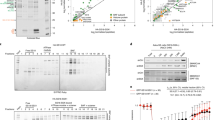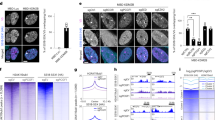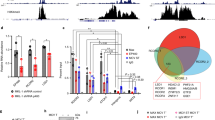Abstract
Localization of β-catenin in the cell is a key determinant in its decision to function as a critical mediator of cell adhesion at the surface or a transcription activator in the nucleus. SYT-SSX2 is the fusion product of the chromosomal translocation, t(X;18)(p11.2;q11.2), which occurs in synovial sarcoma, a soft tissue tumor. SYT-SSX2 is known to associate with chromatin remodeling complexes and is proposed to be involved in controlling gene expression. We report that SYT-SSX2 plays a direct role in β-catenin regulation. When expressed in mammalian cells, SYT-SSX2-induced β-catenin recruitment to the nucleus. Interestingly, known target genes of canonical Wnt were not activated as a result of SYT-SSX2 expression, nor was the nuclear localization of β-catenin due to one of the signaling pathways normally implicated in this event. β-Catenin accumulation in the nucleus led to the formation of a transcriptionally active nuclear complex that contained SYT-SSX2 and β-catenin. More importantly, depletion of SYT-SSX2 in primary synovial sarcoma cells resulted in loss of nuclear β-catenin signal and a significant decrease in its signaling activity. These results unravel a novel pathway in the control of β-catenin cellular transport and strongly suggest that SYT-SSX2 contributes to tumor development, in part through β-catenin signaling.
This is a preview of subscription content, access via your institution
Access options
Subscribe to this journal
Receive 50 print issues and online access
$259.00 per year
only $5.18 per issue
Buy this article
- Purchase on Springer Link
- Instant access to full article PDF
Prices may be subject to local taxes which are calculated during checkout





Similar content being viewed by others

References
Allander SV, Illei PB, Chen Y, Antonescu CR, Bittner M, Ladanyi M et al. (2002). Am J Pathol 161: 1587–1595.
Barker N, Hurlstone A, Musisi H, Miles A, Bienz M, Clevers H . (2001). EMBO J 20: 4935–4943.
Bienz M . (2004). Curr Biol 15: R64–R67.
Brembeck FH, Schwraz-Romond T, Bakkers J, Wilhelm S, Hammerschmidt M, Birchmeier W . (2004). Genes Dev 18: 2225–2230.
Clark J, Rocques PJ, Crew AJ, Gill S, Shipley J, Chan AM-L . (1994). Nat Genet 7: 502–508.
D'Amico M, Hulit J, Amanatullah DF, Zafonte BT, Albanese C, Bouzahzah B et al. (2000). J Biol Chem 275: 32649–32657.
Danilkovitch-Miagkova A, Miagko A, Skeel A, Nakaigawa N, Zbar B, Leonard EJ . (2001). Mol Cell Biol 21: 5857–5868.
dos Santos NR, de Bruijn DRH, van Kessel AG . (2001). Genes, Chrom Cancer 30: 1–14.
dos Santos NR, de Bruijn DRH, Kater-Baats E, Otte AP, van Kessel AG . (2000). Exp Cell Res 256: 192–202.
dos Santos NR, de Bruin DRH, Balemans M, Janssen B, Gartner F, Lopes JM et al. (1997). Hum Mol Genet 6: 1549–1558.
Doucas H, Garcea G, Neal CP, Manson MM, Berry DP . (2005). Eur J Cancer 41: 365–379.
Eid JE, Kung AL, Scully R, Livingston DM . (2000). Cell 102: 839–848.
Elbashir SM, Harborth J, Lendeckel W, Yalcin A, Weber K, Tuschl T . (2001). Nature 411: 494–498.
Hasegawa T, Yokoyama R, Matsuno Y, Shimoda T, Hirohashi S . (2001). Hum Pathol 32: 257–263.
Hoschuetzky H, Aberle H, Kemler R . (1994). J Cell Biol 127: 1375–1380.
Ikura T, Ogryzko VV, Grogoriev M, Groisman R, Wang J, Horikoshi M et al. (2000). Cell 102: 463–473.
Ireton RC, Davis MA, van Hengel J, Mariner DJ, Barnes K, Thoreson MA et al. (2002). J Cell Biol 159: 465–476.
Ladanyi M . (2001). Oncogene 20: 5755–5762.
Ladanyi M, Antonescu CR, Leung DH, Woodruff JM, Kawai A, Healy JH et al. (2002). Cancer Res 62: 135–140.
Miyagishi M, Fujii R, Hatta M, Yoshida E, Araya N, Nagafuchi A et al. (2000). J Biol Chem 275: 35170–35175.
Moon RT, Bowerman B, Boutros M, Perrimon N . (2002). Science 296: 1644–1646.
Nagai M, Tanaka S, Tsuda M, Endo S, Kato H, Sonobe H et al. (2001). Proc Natl Acad Sci 98: 3843–3848.
Patturajan M, Nomoto S, Sommer M, Fomenkov A, Hibi K, Zangen R et al. (2002). Cancer Cell 1: 369–379.
Persad S, Troussard AA, McPhee TR, Mulholland DJ, Dedhar S . (2001). J Cell Biol 153: 1161–1173.
Piedra J, Miravet S, Castano J, Palmer HG, Heisterkamp N, Garcia de Herreros A et al. (2003). Mol Cell Biol 23: 2287–2297.
Playford MP, Bicknell D, Bodmer WF, Macaulay VM . (2000). Proc Natl Acad Sci 97: 12103–12108.
Prieve MG, Waterman ML . (1999). Mol Cell Biol 19: 4503–4513.
Soulez M, Saurin AJ, Freemont PS, Knight JC . (1999). Oncogene 18: 2739–2746.
Staal FJT, van Noort M, Strous GJ, Clevers HC . (2002). EMBO rep 3: 63–68.
Thaete C, Brett D, Monaghan P, Whitehouse S, Rennie G, Rayner E et al. (1999). Hum Mol Genet 8: 585–591.
Thompson B, Townsley F, Rosin-Arbesfeld R, Musisi H, Bienz M . (2002). Nat Cell Biol 4: 367–373.
Tissier F, Cavard C, Groussin L, Perlemoine K, Fumey G, Hagnere A-M et al. (2005). Cancer Res 65: 7622–7627.
van Es JH, Barker N, Clevers H . (2003). Curr Opin Genet Dev 13: 28–33.
Xie Y, Skytting B, Nilsson G, Gasbarri A, Haslam K, Bartolazzi A et al. (2002). Cancer Res 62: 3861–3867.
Acknowledgements
We thank Kelli Gunn and the Al Reynolds group for technical support, Pat Nakatani for the POZ retroviral vector, Hans Clevers and Bert Vogelstein for the TOP-FLASH, FOP-FLASH, MYC-and wt-β-catenin constructs, Jonathan Fletcher for the Syn-1 cells, Ray Mernaugh for help with peptide design and Open Biosystems for the SSX2 antibody. This work was supported by Grants K22 CA098008-01 and R01CA106481-01, and in part by a Cancer Center Support Grant CA68485 and Center in Molecular Toxicology Support Grant EB00672. Some of the work began in David Livingston's laboratory (Dana Farber Cancer Institute) and was supported by Grant NCI CA 15751.
Author information
Authors and Affiliations
Corresponding author
Rights and permissions
About this article
Cite this article
Pretto, D., Barco, R., Rivera, J. et al. The synovial sarcoma translocation protein SYT-SSX2 recruits β-catenin to the nucleus and associates with it in an active complex. Oncogene 25, 3661–3669 (2006). https://doi.org/10.1038/sj.onc.1209413
Received:
Revised:
Accepted:
Published:
Issue Date:
DOI: https://doi.org/10.1038/sj.onc.1209413
Keywords
This article is cited by
-
SS18-SSX drives CREB activation in synovial sarcoma
Cellular Oncology (2022)
-
Synovial sarcoma of the floor of the mouth: a rare case report
BMC Oral Health (2020)
-
The epigenomics of sarcoma
Nature Reviews Cancer (2020)
-
Synovial Sarcoma: A Complex Disease with Multifaceted Signaling and Epigenetic Landscapes
Current Oncology Reports (2020)
-
Monophasic Synovial Sarcoma of Tongue: A Rarest of Rare Case Scenario
Indian Journal of Otolaryngology and Head & Neck Surgery (2019)


